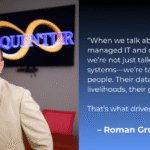Disaster recovery planning isn’t just about hurricanes, floods, or fires—it’s about cyberattacks, system failures, and human error that can bring business operations to a grinding halt. The reality is that many businesses only think about disaster recovery after disaster strikes—and by then, it’s too late.
Every minute of downtime costs money. Studies show that 93% of companies without a disaster recovery plan close within a year of a major data loss event. The question is: if your business went offline right now, how quickly could you recover? If you don’t have a clear answer, it’s time to take disaster recovery planning seriously.
What is Disaster Recovery Planning?
Disaster recovery (DR) is about preparing for and recovering from disruptions, whether they’re caused by a cyberattack, hardware failure, or a natural disaster. A solid disaster recovery plan ensures that critical data is protected, systems can be restored, and business operations can continue with minimal downtime.
Key elements of a disaster recovery plan include a reliable data backup strategy, recovery time objectives (RTO), recovery point objectives (RPO), cybersecurity resilience, and cloud-based continuity solutions. Without these, even a minor IT failure can quickly escalate into a full-blown crisis.
The Biggest Threats to Business Continuity
Disaster recovery isn’t just about preparing for extreme weather events. In fact, cyber incidents and IT failures are far more likely to disrupt business operations than natural disasters. Ransomware attacks have surged in recent years, locking businesses out of their own data and demanding hefty payouts for decryption keys. Without a recovery plan, many businesses have no choice but to pay hackers or suffer massive downtime.
System failures are another common threat. A hardware malfunction or power outage can knock out critical systems, leaving employees unable to work and customers unable to access services. And while cybercriminals and technology failures pose serious risks, human error remains one of the leading causes of data loss. Whether it’s an accidental deletion, a misconfigured setting, or an employee falling for a phishing scam, even the smallest mistake can have huge consequences.
Why Cloud Backups are the Backbone of Disaster Recovery
A disaster recovery plan is only as good as the backups supporting it. Traditional backup methods, like on-premise servers or external drives, are vulnerable to the very same disasters they’re meant to protect against. A flood, fire, or ransomware attack can wipe out local backups in an instant, leaving businesses with no way to recover.
Cloud-based backups provide a secure, scalable, and automated solution. By continuously replicating critical data to offsite, geographically redundant locations, businesses can ensure that they always have a clean copy of their data ready for restoration. Unlike traditional backups, cloud-based solutions allow for instant recovery, minimizing downtime and preventing costly disruptions.
Setting Your Recovery Objectives: RTO & RPO
Not all businesses need the same level of disaster recovery protection. Some companies can tolerate a few hours of downtime, while others need to restore operations within minutes. That’s why two key factors—Recovery Time Objective (RTO) and Recovery Point Objective (RPO)—must be carefully defined.
RTO refers to the maximum acceptable downtime before business operations must be restored. A financial services firm handling time-sensitive transactions will likely have a much lower RTO than a small retail shop. RPO, on the other hand, determines the maximum amount of data loss a business can tolerate. For example, losing an hour’s worth of data might be acceptable for some businesses, while others can’t afford to lose more than a few seconds.
By working with Sequentur, businesses can develop a customized disaster recovery strategy that aligns with their specific RTO and RPO needs, ensuring that systems are restored quickly and data loss is minimized.
Why Testing Your Disaster Recovery Plan is Critical
A disaster recovery plan isn’t something you set and forget. Too many businesses assume they have a solid plan in place—only to discover its flaws when disaster actually strikes. Without regular disaster recovery drills, businesses risk finding out too late that their backups are outdated, their failover systems don’t work, or their employees don’t know the right protocols to follow.
Testing a disaster recovery plan ensures that data can be restored, systems can be rebooted, and employees know exactly what to do when an incident occurs. These drills also help refine response times, uncover weaknesses, and improve overall preparedness.
Cybersecurity & Disaster Recovery: A Unified Strategy
A strong disaster recovery plan isn’t just about restoring data—it’s about preventing cyber incidents from happening in the first place. With cyber threats on the rise, businesses need advanced security measures to detect and neutralize attacks before they escalate into full-scale disasters.
This is where Sequentur’s partnership with CrowdStrike makes a difference. By integrating AI-powered endpoint protection, real-time threat intelligence, and proactive monitoring, businesses gain a multi-layered defense against ransomware, malware, and phishing attacks. With Sequentur and CrowdStrike, threats are identified and contained before they can do serious damage, making disaster recovery a last resort rather than a constant necessity.
Is Your Business Disaster-Proof?
The reality is that disasters—whether cyber or natural—are inevitable. The difference between businesses that recover and those that don’t comes down to planning. If your organization doesn’t have a fully developed, regularly tested disaster recovery plan, now is the time to build one.
Sequentur provides end-to-end disaster recovery solutions, including automated cloud backups, business continuity planning, real-time threat monitoring, and rapid recovery services. Don’t wait for a crisis to expose vulnerabilities in your IT infrastructure—get ahead of the risks and protect your business today.
Contact Sequentur for a free disaster recovery assessment and ensure your business is prepared for anything.















